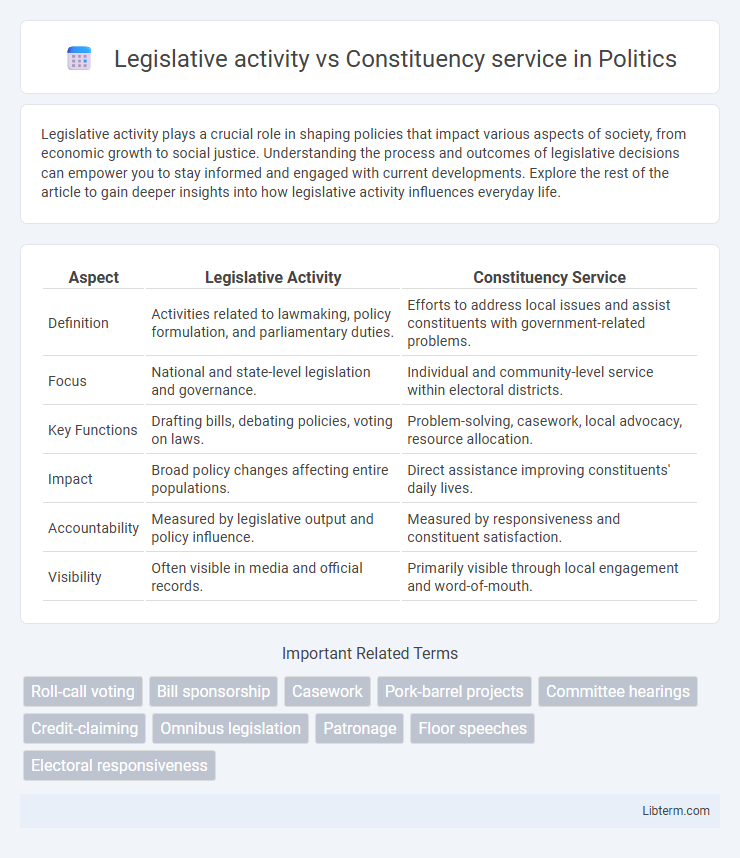Legislative activity plays a crucial role in shaping policies that impact various aspects of society, from economic growth to social justice. Understanding the process and outcomes of legislative decisions can empower you to stay informed and engaged with current developments. Explore the rest of the article to gain deeper insights into how legislative activity influences everyday life.
Table of Comparison
| Aspect | Legislative Activity | Constituency Service |
|---|---|---|
| Definition | Activities related to lawmaking, policy formulation, and parliamentary duties. | Efforts to address local issues and assist constituents with government-related problems. |
| Focus | National and state-level legislation and governance. | Individual and community-level service within electoral districts. |
| Key Functions | Drafting bills, debating policies, voting on laws. | Problem-solving, casework, local advocacy, resource allocation. |
| Impact | Broad policy changes affecting entire populations. | Direct assistance improving constituents' daily lives. |
| Accountability | Measured by legislative output and policy influence. | Measured by responsiveness and constituent satisfaction. |
| Visibility | Often visible in media and official records. | Primarily visible through local engagement and word-of-mouth. |
Understanding Legislative Activity: Core Responsibilities
Legislative activity primarily involves drafting, debating, and voting on bills that shape national policies and laws within parliamentary or congressional sessions. Core responsibilities include committee work, policy analysis, and ensuring that legislation aligns with constitutional and public interests. This activity demands detailed knowledge of legal frameworks, negotiation skills, and engagement with expert testimonies to effectively represent the legislative agenda.
The Nature of Constituency Service
Constituency service primarily involves direct assistance to constituents, addressing individual needs such as helping with government benefits or resolving local issues, which enhances a legislator's local support. Unlike legislative activity that emphasizes policy-making and law formulation, constituency service is more personalized and immediate, fostering strong ties between elected officials and their electorate. This hands-on approach increases voter satisfaction and trust, reinforcing political accountability at the local level.
Key Differences Between Legislative Work and Constituent Support
Legislative activity primarily involves drafting, debating, and voting on laws that shape public policy and governance at various government levels. Constituency service focuses on addressing individual and community concerns by assisting constituents with government programs, resolving local issues, and providing guidance on bureaucratic processes. The key difference lies in legislative work's broader policy impact versus constituency service's direct, personalized support to voters within a district.
Impact of Legislative Activity on Policy Outcomes
Legislative activity directly influences policy outcomes by shaping laws and regulations through bill sponsorship, committee work, and floor debates, which determine the scope and implementation of public policies. Effective lawmakers who engage in substantive legislative processes can drive significant changes in areas such as healthcare, education, and economic development, reflecting their ability to address constituent needs on a broader scale. This contrasts with constituency service, which primarily impacts individual or localized concerns without necessarily altering overarching policy frameworks.
The Role of Constituency Service in Electoral Success
Constituency service significantly enhances electoral success by fostering strong voter relationships and demonstrating tangible benefits delivered to the electorate, which often outweighs legislative achievements in importance to constituents. Empirical studies show that legislators who actively engage in addressing local needs and casework tend to secure higher re-election rates due to increased voter satisfaction and trust. This direct interaction creates a personalized connection between representatives and voters, reinforcing loyalty and boosting campaign effectiveness in competitive districts.
Balancing Lawmaking and Constituent Needs
Balancing lawmaking and constituent needs requires legislators to allocate time between drafting and voting on policies and addressing individual concerns within their districts. Effective representatives prioritize constituent service by resolving local issues while ensuring legislative activity aligns with broader policy goals. Maintaining this equilibrium enhances democratic responsiveness and strengthens voter trust.
Measuring Effectiveness: Legislative Output vs Constituent Satisfaction
Legislative activity effectiveness is commonly measured by legislative output, including the number of bills sponsored, laws passed, and committee participation. Constituency service effectiveness is evaluated through constituent satisfaction surveys, casework resolution rates, and responsiveness to individual concerns. Comparing these metrics highlights the trade-off between policy impact and direct voter engagement, influencing representative accountability and re-election prospects.
Challenges Faced by Lawmakers in Prioritizing Duties
Lawmakers face significant challenges in balancing legislative activity and constituency service, often struggling to allocate time effectively between crafting policy and addressing local concerns. Constituency demands for immediate assistance and personalized attention can detract from the time needed for detailed legislative research and collaboration on national issues. This tension complicates prioritization, as failure to meet local expectations risks political support, while neglecting legislative duties undermines broader governance responsibilities.
Case Studies: Politicians Excelling in Both Areas
Politicians like Senator Elizabeth Warren demonstrate exceptional legislative activity by sponsoring significant financial reform bills while maintaining strong constituency service through regular town hall meetings and personalized casework assistance. Similarly, Representative Alexandria Ocasio-Cortez balances high-profile legislative initiatives on climate change with active engagement in her district's community events and constituent outreach programs. These case studies highlight the effectiveness of integrating lawmaking expertise with hands-on support to address voter needs comprehensively.
Trends Shaping Legislative Activity and Constituency Service
Legislative activity increasingly emphasizes data-driven policy-making and bipartisan collaboration, reflecting trends toward transparency and technological integration in lawmaking processes. Constituency service is evolving with digital engagement platforms, enabling representatives to respond more efficiently to voter concerns and foster stronger community ties. Both spheres show a convergence towards enhanced communication strategies and responsiveness, driven by the growing demand for accountability and personalized constituent interactions.
Legislative activity Infographic

 libterm.com
libterm.com